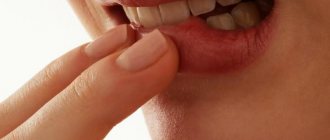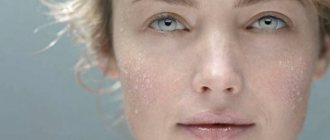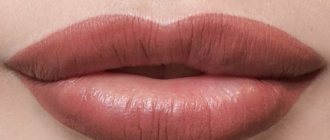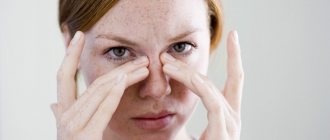Causes of purulent discharge from the nipples
Mastitis
Purulent discharge is most often caused by inflammation of the mammary gland.
In 90% of cases, this is associated with breastfeeding (lactation mastitis). Droplets of purulent discharge from the nipples appear after pressing on the chest; their release can be facilitated by squeezing the breast gland with a tight bra. Mastitis is characterized by damage to only one breast, which is manifested by sharp asymmetry due to tissue swelling. Women note a combination of discharge with redness of the skin, severe pain in the affected area, and an increase in temperature. Non-lactation mastitis occurs with a similar clinical picture. Some patients associate the presence of purulent discharge with chest bruises and skin injuries (cuts, abrasions). The flow of pus from one nipple begins when pressure is applied to the areola area. The symptom is accompanied by unbearable pain in the mammary gland, the skin in this area becomes red and very hot to the touch. Suppuration from the nipple is a sign of severe bacterial damage to the glandular tissue, so the patient should seek medical help as soon as possible.
Breast abscess
Without treatment, the inflammatory disease often develops into a breast abscess - a massive formation filled with pus. This condition is combined with the periodic spontaneous appearance of purulent discharge from the nipples; blood clots and admixtures of necrotic tissue can be found in the discharge. The mammary gland is very swollen, women complain of sharp pain at rest, which intensifies with movement. Suppuration with the release of scanty thick yellow-green contents also occurs with the formation of fistulas due to chronic inflammation.
There may be shocking photos of medical operations hidden here that show blood and guts.
Are you over 18 years old?
Yes
No
Local purulent processes
The cause of pus discharge from the nipples can be inflammatory skin lesions - boils and carbuncles, if they are localized in the areola area. Pathological discharge appears when an abscess is opened into the lumen of the milk ducts. Patients note the sudden appearance of thick greenish pus with a strong unpleasant odor; the amount of purulent discharge varies from a couple of drops to several milliliters. On the skin of the chest, closer to the nipple, a painful hyperemic elevation is found. After the pus drains, the condition improves and the pain subsides.
Rare causes
- Surgical complications
: infection of mammary tissue after surgery. - Suppuration of neoplasms
: intraductal papillomas, adenocarcinoma. - Damage to the nipples
: non-compliance with the technique of expressing milk, presence of piercings. - Purulent breast cyst
.
Subjective first signs of pregnancy
Often the first changes in the body that a woman differentiates as signs of pregnancy may turn out to be symptoms of PMS. However, if you have never suffered from premenstrual syndrome before, you should pay attention to these:
- Feeling of weakness, malaise and increased fatigue even with usual exercise.
- The appearance of drowsiness during the day and insomnia at night.
- Unstable emotional state. A woman’s mood can change dramatically in a matter of seconds without good reason.
- A feeling of heaviness in the lower abdomen, lower back and pelvic area.
- Constant headache and dizziness.
- Change in libido. Moreover, it can either decrease or increase.
- Periodic sensations of heat or chills that replace each other.
- Increased sensitivity of the mammary glands to the point that any touch to the breast results in extremely unpleasant sensations and even pain.
- Increased appetite or change in eating habits. From the first days of pregnancy, a girl may want to eat more or eat dishes that she did not like before.
- The appearance of an unreasonable feeling of nausea. In some cases, heartburn and vomiting occur. This condition is called toxicosis.
- Increased sensitivity to odors and distortion of the sense of smell.
All of the above signs cannot accurately answer the question: has pregnancy occurred or not? However, they allow us to suspect it and move on to more accurate and reliable diagnostic methods.
Diagnostics
A specialist mammologist or surgeon examines patients with suppuration from the nipples. During the diagnosis, the doctor collects a detailed medical history, conducts an external examination and palpation of the mammary glands to make a preliminary diagnosis. To establish the causes of purulent discharge, a set of laboratory and instrumental methods is prescribed, the most informative of which are:
- Ultrasonography
. Sonography is a non-invasive diagnostic method that is recommended in all cases of nipple discharge. Using ultrasound of the mammary gland, the structure of the alveolar tissue and milk ducts are visualized, deformations, cysts, and other voluminous neoplasms are detected. - X-ray examination
. Mammography is more informative in patients over 40 years of age, whose breast tissue is less dense. Using an x-ray, the doctor evaluates the structure of the glandular tissue, its homogeneity and echogenicity. To clarify the diagnosis, if necessary, a CT scan of the mammary glands is performed. - Laboratory methods
. Accurate determination of the type of pathogenic microorganism that caused purulent inflammation is necessary to select a treatment regimen. Bacteriological culture is supplemented by rapid bacterioscopy of pus smears and a study of the sensitivity of the isolated microflora to antibiotics. To detect nonspecific signs of the inflammatory process, general and biochemical blood tests are indicated.
If a space-occupying lesion is detected, ultrasound-guided puncture is necessary to differentiate abscesses from suppuration of a tumor formation. Cytological examination of purulent discharge from the nipple is carried out in doubtful cases to exclude oncological pathology.
Nipple smear examination
Clinical symptoms at the beginning of pregnancy
Already in the first few days after conception, the following conditions and changes in the body of a pregnant girl may develop:
- Early factor. This is the name of a special substance that is released 1-2 days after fertilization. According to the data obtained, it is found in 67% of examined women whose pregnancy was subsequently confirmed.
- Bloody discharge from the genital tract. They may have a yellowish or pinkish tint and appear when the fertilized egg attaches to the uterine walls. This usually happens at the end of the first, beginning of the second week after conception.
- The increase in basal temperature that appeared at the time of ovulation persists for a long time if fertilization has occurred. Its measurement can indirectly confirm the occurrence of pregnancy. The general body temperature may also rise to 37 degrees.
- Paresthesia, pain and cramps in the calf muscles. As a rule, they occur late in the evening or at night, causing sleep disturbances and even insomnia.
- A decrease in blood pressure, which is manifested by severe weakness and dizziness. With significant hypotension, fainting is possible. The risk of developing this condition is prolonged exposure to a stuffy, unventilated room or standing position.
- Decreased immunity. Manifested by frequent colds. Also, against the background of immunodeficiency, pregnant women may be bothered by genital candidiasis or, in other words, thrush.
- Increased urge to urinate. Most often this symptom appears in later stages of pregnancy, but it can also occur in the first days.
Despite the huge number of signs, most often a woman pays attention to a delay in menstruation. And for good reason. This is the most obvious and accurate symptom that should lead you to certain thoughts. Of course, menstrual irregularities occur in a huge number of pathological conditions. However, if you are planning a pregnancy, a delay may be the first bell indicating the onset of the long-awaited conception.
Immediately after the onset of the above sign, you can conduct a test that is sensitive to an increase in hCG.
Treatment
Help before diagnosis
The appearance of purulent discharge from the nipples indicates a massive inflammatory process in the mammary glands, so self-medication can lead to serious complications and generalization of the infection. You should not specifically squeeze the breasts and areola to squeeze out pus; it is undesirable to wear tight bras, as they increase the discomfort. For unbearable pain in the affected chest, various analgesics are used. Self-administration of antibiotics without a doctor’s prescription risks the disease becoming chronic, which is less treatable.
Conservative therapy
Medical tactics depend on the degree of tissue damage, the presence of encapsulated purulent foci, and the general condition of the woman. Drug treatment as an independent method is used only in the early stages of the disease. During the treatment period, the mammary gland is given an elevated position to reduce pain. Nursing mothers need to regularly use a breast pump to prevent lactostasis. For suppuration from the nipples, the following is prescribed:
- Antibiotics
. Etiotropic drugs are selected taking into account the sensitivity of the pathological microflora. The primary drugs administered are cephalosporins or penicillins; in severe bacterial cases, combinations of antibiotics are used. - NSAIDs
. The medications reduce the concentration of inflammatory molecules in the breast tissue, which reduces pain in patients. For severe pain, anti-inflammatory drugs that have a powerful analgesic effect are selected. - Infusion formulations
. Intravenous administration of glucose-salt and protein solutions is recommended for detoxification of the body in case of extensive purulent inflammation. The drugs can be used together with antihistamines and immunomodulators.
Surgery
The accumulation of pus in the mammary gland is an indication for minor surgical intervention - opening of purulent foci and installation of drains. In the presence of a single abscess of small size, it is usually limited to puncture of the formation under ultrasound guidance followed by aspiration of the contents. When a large abscess forms, purulent melting of glandular tissue requires opening and drainage of mastitis, extended operations, including excision of the affected areas (sectoral resection, quadrantectomy).
External changes during the first days of pregnancy
Also, in addition to the symptoms indicated in the previous section of the article, which the woman notes herself, certain external changes occur that are noticeable to the people around her.
Due to hormonal changes, skin problems may appear. Many girls who have not previously suffered from acne notice that rashes begin to appear.
Swelling of the face, arms and legs also accompanies pregnancy, including in the early stages. Sometimes their severity reaches such an extent that the girl cannot walk in her usual shoes.
Breasts can increase by 1-2 sizes already in the first weeks of pregnancy. At the same time, the appearance of a venous vascular pattern and darkening of the nipple areola are noted.
The pigmentation of the midline of the abdomen, running from the navel to the pubis, also increases. This symptom is observed in most pregnant women.
A blush often appears on the skin of the face. This sign is explained by increased blood flow in the body of the expectant mother.
Should I worry if my pacifier has become indispensable?
First off: what's the difference?
It's actually simple. A nipple is a product that is shaped like a female nipple and is placed on a bottle. That is, there is a hole in the nipple, and it is intended for feeding the baby. A pacifier is also a product that resembles a nipple, but there is no hole in it, and you cannot feed your baby through it. A child can only suck a pacifier and a pacifier, nothing else. Therefore, I will consider them together.
Now about the myths. There are quite a lot of them on the Internet and I will explain the most common ones about nipples (pacifiers).
The pacifier “spoils” the bite.
True, with one “but”.
A pacifier is one of the reasons for the formation of primary malocclusion pathologies in children if:
- the child is over 1 year old (all primary incisors have erupted, and by 3 years all primary teeth have erupted)
- use of the pacifier is unlimited (24 hours a day)
- with prolonged use of a pacifier, almost 80% of children develop an abnormal primary bite (the primary teeth of the upper jaw move forward)
- weaning from her was quick
For example, if not properly weaned from a pacifier, a child may start thumb sucking. And this is already a bad habit.
According to one study, in children who already have primary malocclusion pathology, with proper and timely weaning from the pacifier, the dental system can recover on its own (65-83%). In addition, the presence of such a bite of primary teeth does not mean that the permanent bite is not formed correctly.
A small conclusion: if you use the pacifier correctly, following the recommendations of doctors, indications and contraindications, you can avoid harmful consequences.
The pacifier calms the baby.
Of course it's true.
The pacifier helps satisfy the sucking reflex, the baby calms down and falls asleep, and sleeps more peacefully at night with it. And mommy can absolutely use this. Of course, you can use it less often during the day.
The pacifier disrupts breastfeeding, problems arise, and a pacifier should not be used at all during breastfeeding.
True in some situations.
Sucking a mother's breast is a serious job for a child: you need to latch onto the breast correctly (the pacifier has a smaller latching area), actively suck on the breast to get enough milk (it is easier to suck on the pacifier, since the hole/s in it are larger and the milk flows faster).
Indeed, when there is not enough milk, the baby is supplemented with formula, then you need to choose the right pacifier (and continue to apply it to the breast in order to normalize lactation), since the child will not want to strain and will suck the breast sluggishly, will receive less milk, and therefore will worry more often. The baby may also bite and cracks may appear on the nipples. In this case, it is recommended not to give a pacifier to a healthy child unless indicated until breastfeeding is established (this is up to 1 month).
The pacifier can be used, but according to indications and for a limited time. Therefore, in the maternity hospital, the mother should consult with a doctor: is a pacifier necessary, how to maintain lactation, how correctly the child should latch onto the breast, what feeding technique and care for the mammary glands.
The risk of developing acute otitis media increases when using pacifiers.
This opinion is based on one study conducted in Finland with children aged 7-18 months, which found that the risk of developing acute otitis media (middle ear infection) was 29% lower in children who did not suck a pacifier. According to some experts, this depends on changes in pressure in the ears and leads to the accumulation of fluid inside the middle ear, the infection of which leads to the development of the disease.
I have a counter question: how long should a child suck a pacifier per day for a pressure shift to occur? To this I can only say one thing: you need to use the pacifier correctly.
A pacifier in the mouth is a source of infection.
Is it true.
It's a matter of hygiene:
- wash the pacifier once a day with baby soap or a special care product
- be sure to sterilize by boiling or in a bottle sterilizer before first use and in subsequent use
- use a container to store it
- If the pacifier falls on the floor, do not lick it! Rinse under running water or rinse with boiling water
- monitor the condition of the pacifier surface (presence of damage). If there is even one small scratch, change the pacifier. Uneven surfaces serve as a breeding ground for germs
A pacifier “slows down” a child’s development.
The sucking reflex is an important stage in the development of a child and, accordingly, it is temporary. In children under one year of age (after the reflex physiologically fades away), problems may arise if the sucking reflex is dissatisfied. But every mother should understand that the breast is the best option for the child, so a pacifier is a backup option.
Also, babies grow up to be more sociable and sociable (unless prolonged pacifier sucking has led to malocclusion and speech impairment).
It is difficult to wean a child off a pacifier, as it is addictive.
Is it true.
A child's sucking reflex is pronounced from birth and only by the age of 3 it fades away completely. At this time, it is important to gradually and with minimal stress for the child wean him off the pacifier, as this can then become a habit.
Some doctors believe that it is easiest to wean a child at the age of 1-1.5 years and does not need to be delayed until 3-4 years. The following is a list of when it is necessary to wean a child off a pacifier:
- child's age 3 years
- the child sucks a pacifier for a long time during the day with breaks for food
- the child does not want to communicate with peers and play interactive games
- The doctor discovered a speech delay in the child
As for the weaning process itself, there are also several rules:
- you need to start during a period of complete health, and in the absence of other stressful situations (kindergarten, potty training, sleeping separately, moving, etc.)
- There is no need to smear the pacifier with something tasteless, spicy or sour - the child can get this product into his eyes and nose, which can lead to an allergic reaction and other undesirable consequences
- Gradually cutting off the rubber part of the pacifier is also not an option, since the child may bite off a piece of it
What should you do then? There are many different methods on the Internet, but they are all divided into quick and gradual methods.
The quick method is tougher, but also the most reliable: at one point the mother simply hides it and doesn’t show it again, doesn’t remind her of the pacifier. This method is difficult, because not only the child sheds tears and throws hysterics, but the parents also suffer while looking at it. Also, parents need to stand firmly on their own and not make concessions to the child.
The gradual method is more loyal and calm. The point is to distract the child as often as possible, keep him busy with activities and games without the presence of a pacifier nearby, leading to the point that the child completely refuses or forgets about it.
When a child needs a pacifier only before falling asleep, you need to choose another way to put the child to sleep: read fairy tales, conduct a dialogue with the child.
Another method is to give it to another small child (baby). Not all, but many children are ready to part with their pacifier for the benefit of another child.
A child's love for a pacifier can develop into bad habits.
Smoking. Some psychologists argue that smoking is a consequence of an unsatisfied sucking reflex. That is, it’s the other way around - insufficient use of a pacifier led to smoking. Or another bad habit - biting your nails.
The habit of biting nails occurs in people who do not tolerate stress, tension and anxiety well. This is their way to calm down and it has nothing to do with the pacifier.
Be healthy!
Sincerely, Oksana Olegovna.







